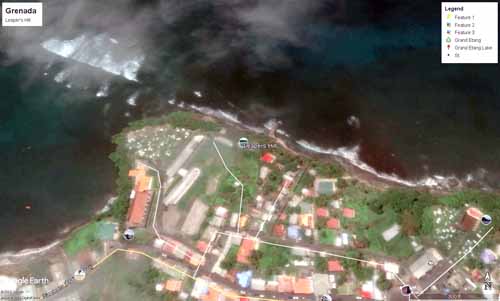Leaper's Hill or Carib's
Leap Grenada |
This is where scores of Caribs jumped to their deaths to avoid being enslaved. |
||||
|
Leaper's Hill (AKA Carib's Leap) Leaper's Hill also known as Carib's Leap is located north of the town of Sauteurs on the promontory where St. Patrick's Roman Catholic Church, School and Cemetery are located. Drive up the hill past the school to the cemetery gate. Walk through the cemetery gate to the steep cliff face that drops over 100
feet to the sea. This is the point where Grenada's Carib inhabitants are said to have jumped
to their deaths rather than be enslaved. 
The Caribs were not Grenada’s original inhabitants. Several tribes from South America settled the island as long as 2,000 to 3,000 years ago. Eventually, a tribe known as the Arawaks became the dominant tribe. Although they settled many other islands, they are considered a peaceful group, more interested in agriculture than war and expansion. Christopher Columbus sighted Grenada on August 15th, 1498. Europeans did not bother with Grenada for more than a hundred years. By the 1600s, the island's Carib population is believed to have been larger than on many other islands because Grenada's hunting and fishing grounds were so rich. The first attempt at settlement wasn't until 1609 when the British established a settlement called Megrin Town atop the ridge overlooking La Sagesse Bay. The Caribs did not appreciate these interlopers and harassed them constantly. The English settlers abandoned their settlement for Trinidad and did not return. The French attempted colonization around 1626 and were met by such fierce Carib hostility they quickly retreated. In 1650, about 200 French settlers convinced the Caribs to sell them land in exchange for some knives and hatchets, lots of glass beads and 2 bottles of brandy given the Carib chief. The situation remained calm until a year later the Caribs started hostilities again. They wanted their land back and the French to leave. The settlers reinforced their colony and decided to eliminate the Carib threat for good. Armed with guns, they captured the Carib's most important village. The Caribs with their bows and arrows retreated to Grenada's east coast. Other Caribs arrived from St. Vincent to help fight the British. With an estimated 800 warriors, the Caribs made the mistake of attacking a French fort. Bows and arrows against cannon and scores of muskets turned it into a suicide attack. The Caribs were easily defeated. The French decided to end the Carib threat forever and drove the Indians to a promontory on the northern part of the island. Although they fought fiercely, they were defeated. An estimated 40 Caribs or more, the only survivors, threw themselves from the cliff rather than surrender. In their memory the French named the spot ?Le Morne de Sauteurs,? Hill of Leapers/Jumpers. Today, it's simply Leaper's Hill. When visiting Leaper's Hill, examine some of the headstones in the cemetery. On the basis of the dates of birth and death carved on the markers, the average life span of Grenadians was quite long before the advent of modern medicine. That's what a diet of fresh fruits and vegetables can do for you.
|
|||||
